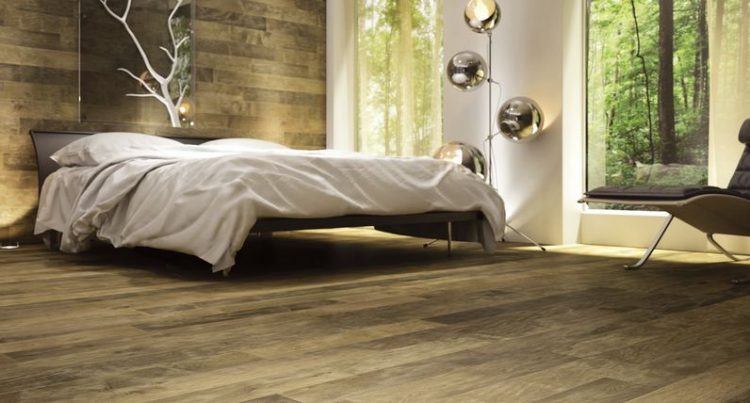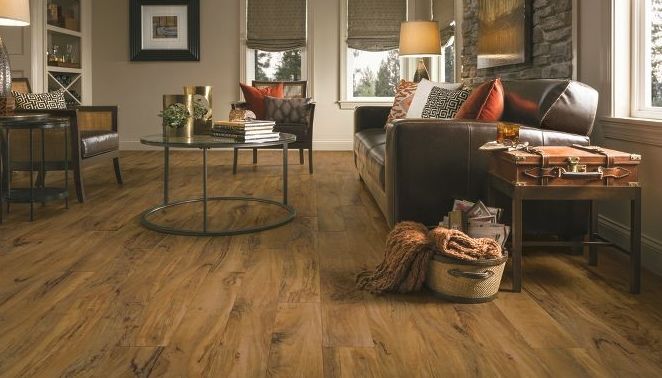
As flooring options continue to become available to eager consumers searching for the next best possible product, many technologies, such as heated floor tile systems, continue to evolve. It is now possible, for example, to install floor heating systems under porcelain, ceramic or stone tiles; vinyl or carpet tiles; and even wood when embedded properly in cement. Radiant floor heating has become a much more common option than in the past.
Of course, luxury composites or wooden floors still dominate purchases. But tech savvy consumers are seeking the latest, often transferring commercial applications to home use. Some of the newest offer better home environments and have received industry awards. Others provide lighting and colors previously impossible. Still more have been part of scientific research for years, with hopes of coming to the market to aide patients and their families.
Here are five fascinating options.
1. Pure Genius by Lauzon Flooring

Pure Genius is an air purifying ingredient which is made from titanium dioxide. Lauzon Flooring has integrated this agent into their floor finishes. It is activated by light and the company has said that, over time, these floors do not lose performance and work continuously. There are active nanoparticles in the Pure Genius floors which decompose pollutants including formaldehyde, converting these harmful contaminants into harmless carbon dioxide and water molecules.
Pure Genius is self-starting. Both Artificial and natural light activate the particles of titanium dioxide in its finishes. Then, as air circulates through the room, whether it be from someone moving through the room or a fan that is blowing air, the toxic contaminants in the air contact the activated Pure Genius nanoparticles. This converts the VOCs into CO2 plus H2O.
Lauzon notes that homes with its Pure Genius floors have air that can become purer by up to 85% as time passes. This flooring is definitely a double duty product that is expected to be at the top of the public’s want list.
The air-purifying benefits provided by Pure Genius are many:
- This product is the only hardwood floor on the earth which purifies the air
- The air can be as much as 85% more pure than without this flooring
- The floor decomposes as much as 99.6% of the viruses, bacteria and mold it contacts
- It actively suppresses emissions which have the potential to be cancer causing from air-borne pollutants such as solvents, formaldehyde, and volatile organic compounds
- It reduces symptoms associated with allergies, asthma and other respiratory or immuno-suppressive disorders
- Provides cleaner floors by dispersing hardwood floor cleaners readily
- Reduces pet odors
- Reduces stubborn cooking and smoke odors
- Provides a healthier breathing environment for children and adults
Pure Genius works to better the air quality in the home’s spaces and helps to improve the health of those who spend time there.
2. Armstrong Vivero Luxury Flooring

This surface won the Best of Surfaces 2016-Technology award at the International Surface Event 2016 Trade Show held in Las Vegas, Nevada. The floor planks are made with cultured diamonds. Named Diamond 10 Technology by Armstrong, the patents are pending for this long lasting, highly durable flooring.
Vivero™ Luxury Flooring with patent-pending Diamond 10™ Technology. Made with cultured diamonds, the floor planks repel spills, are 100% waterproof, resist stains and dirt, are easy to install and good for homes with young children and pets.
The flooring is made in Lancaster, Pennsylvania, and certified to either meet or to exceed industry standards for low emissions. This is a flooring that will not reduce the quality of the home’s indoor air.
The diamonds provide performance that is long lasting, scratch resistant, and easy to clean. The planks offer high appeal for many families because of they look like real wood. Another plus is that the product has a locking system which is the very first of its kind. The planks interlock to provide secure installation over most subfloors.
3. The EFun LED Dance Floor

Made by Shenzhen Efun Innovation Electronic Technology Co., Ltd., located in Shenzhen China, the LED Dance floor can be used for dance performances, dances, concerts and theater presentations. It is a modular, digital display device, constructed with a base made of high strength ABS materials. The glass used is tempered so that each module can be connected to the next seamlessly. An array of lights is controlled using synchronous controls to achieve an exciting display. This high tech floor has many details which offer variety and bright light underfoot:
- It is rainproof and will withstand a crowd.
- It has an LED ground display screen.
- It can create reliable, bright color 3D effects.
- It functions noiselessly, is energy efficient, and functions with the need for an auxiliary cooler.
- Suitable for both indoors and out; it has an IP55 waterproof grade.
- Simple to install; it operates with a fixed dock connector.
- It is DMX, SD WIFI and remote function capable.
- The bass chassis is high-strength ABS materials, using tempered glass panels with high end lamp bodies.
- It can operate using independent software, wireless remote control and has DMX and audio controls.
4. The ASB GlassFloor

The German ASB GlassFloor is the world’s most advanced flooring system. It is constructed with an aluminium substructure and a custom-manufactured glass surface built of reinforced glass panels. It is the deal sports floor, but it also appropriate for a contemporary building design. The floor contains LED lines which can be changed on demand. It is also possible to simply turn them off completely. The glass is ceramic, with a semi-opaque finish which controls light reflection. The lighting elements are embedded within the substructure of the floor.
The floor is similar in texture to a traditional basketball court made of hardwood. There are ceramic dots burnt into the surface to provide friction and protection against slips. Players can dive for balls and interact the same way as they would on conventional floors.
The lighting controls allow for multipurpose use of the floor. The markings are flexible and can be changed to accommodate different sports. The floor will also project messages and scoreboards underneath its surface.
There are many unique construction details:
- The floor’s tempered security glass will withstand enormous impacts.
- The floor panels are actually two glass plates with a safety layer sandwiched between.
- The glass is specially treated and can be created to a dimension exceeding 2 meters square.
- The floor will last far longer than a conventional one, even when used outdoors.
- Treatments to achieve ideal light reflection, friction and elasticity are completed on the glass surface.
- Extensive tests have resulted in optimal light reflection, friction and deflection levels for sports.
- Each floor is EN and ISO certified.
- The surface color may be customized and changed years later.
5. The Smart Carpet

In a project funded by the Alzheimer’s Association, University of Missouri Professor of Electrical and Computer Engineering Harry Tyrer, Jr. developed the smart carpet within the last decade. The carpet was actually a flooring system with electronics and sensors designed to send data from the carpet to a computer for analysis. The sensors monitored walking activity, with the goal of helping patients move more safely. The information gathered was designed to assess injury risks. The work also focused on programming the carpet flooring system to detect the differences between potential falls and simple walking movements.
Tyrer, along with graduate students working as a team, developed a prototype system and began the work of reducing the electronics. Their goal was to shrink the components to cell phone size, and to function with a $99 computer. The reasonable price was a goal to make the carpet financially feasible for many families.
The smart carpet would ideally send a signal to its computer, which would evaluate the information and notify a caregiver using a local alarm, a telephone call or a signaling device. Tyrer was hopeful that pressure sensitive transistors being developed by another scientist could be used within the carpet design. Ultimately, carpets could transmit vital information to caregivers about patients’ movements, pinpointing their exact location.
Though the smart carpet prototype was in development, the hopes of the scientific team included marketing it through the eldercare system to provide safety alternatives for patients at risk of stumbling, falls and leaving safe areas. The future of this useful and intriguing technology is yet to be determined.


Comments
Loading…